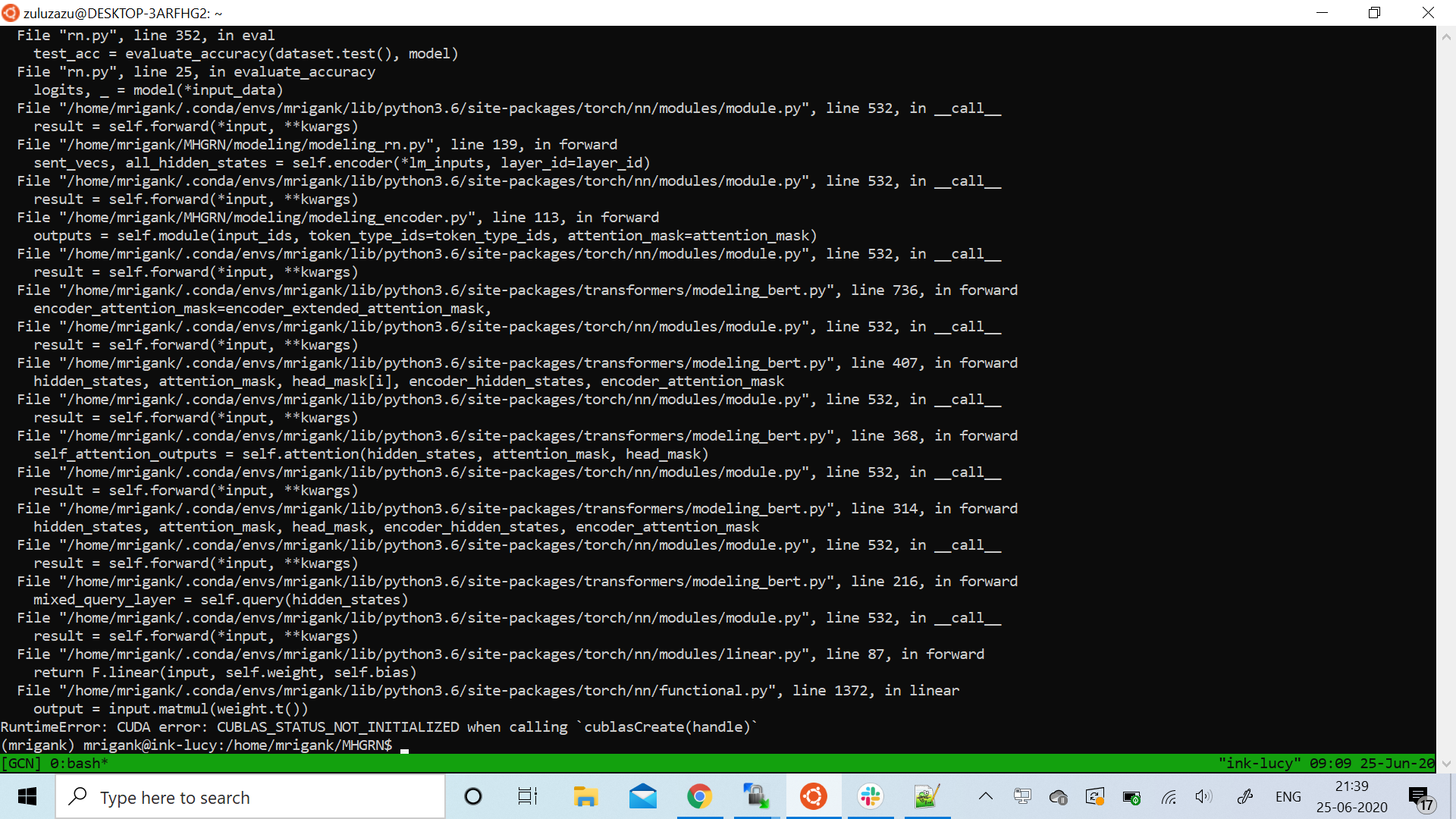This is the repo of our EMNLP'20 paper:
Scalable Multi-Hop Relational Reasoning for Knowledge-Aware Question Answering
Yanlin Feng*, Xinyue Chen*, Bill Yuchen Lin, Peifeng Wang, Jun Yan and Xiang Ren.
EMNLP 2020.
*=equal contritbution
This repository also implements other graph encoding models for question answering (including vanilla LM finetuning).
- RelationNet
- R-GCN
- KagNet
- GConAttn
- KVMem
- MHGRN (or. MultiGRN)
Each model supports the following text encoders:
- LSTM
- GPT
- BERT
- XLNet
- RoBERTa
We provide preprocessed ConceptNet and pretrained entity embeddings for your own usage. These resources are independent of the source code.
Note that the following reousrces can be download here.
| Description | Downloads | Notes |
|---|---|---|
| Entity Vocab | entity-vocab | one entity per line, space replaced by '_' |
| Relation Vocab | relation-vocab | one relation per line, merged |
| ConceptNet (CSV format) | conceptnet-5.6.0-csv | English tuples extracted from the full conceptnet with merged relations |
| ConceptNet (NetworkX format) | conceptnet-5.6.0-networkx | NetworkX pickled format, pruned by filtering out stop words |
Entity embeddings are packed into a matrix of shape (#ent, dim) and stored in numpy format. Use np.load to read the file. You may need to download the vocabulary files first.
| Embedding Model | Dimensionality | Description | Downloads |
|---|---|---|---|
| TransE | 100 | Obtained using OpenKE with optim=sgd, lr=1e-3, epoch=1000 | entities relations |
| NumberBatch | 300 | https://github.com/commonsense/conceptnet-numberbatch | entities |
| BERT-based | 1024 | Provided by Zhengwei | entities |
- Python >= 3.6
- PyTorch == 1.1.0
- transformers == 2.0.0
- tqdm
- dgl == 0.3.1 (GPU version)
- networkx == 2.3
Run the following commands to create a conda environment (assume CUDA10):
conda create -n krqa python=3.6 numpy matplotlib ipython
source activate krqa
conda install pytorch=1.1.0 torchvision cudatoolkit=10.0 -c pytorch
pip install dgl-cu100==0.3.1
pip install transformers==2.0.0 tqdm networkx==2.3 nltk spacy==2.1.6
python -m spacy download enFirst, you need to download all the necessary data in order to train the model:
git clone https://github.com/INK-USC/MHGRN.git
cd MHGRN
bash scripts/download.shThe script will:
- Download the CommonsenseQA dataset
- Download ConceptNet
- Download pretrained TransE embeddings
To preprocess the data, run:
python preprocess.pyBy default, all available CPU cores will be used for multi-processing in order to speed up the process. Alternatively, you can use "-p" to specify the number of processes to use:
python preprocess.py -p 20The script will:
- Convert the original datasets into .jsonl files (stored in
data/csqa/statement/) - Extract English relations from ConceptNet, merge the original 42 relation types into 17 types
- Identify all mentioned concepts in the questions and answers
- Extract subgraphs for each q-a pair
The preprocessing procedure takes approximately 3 hours on a 40-core CPU server. Most intermediate files are in .jsonl or .pk format and stored in various folders. The resulting file structure will look like:
.
├── README.md
└── data/
├── cpnet/ (prerocessed ConceptNet)
├── glove/ (pretrained GloVe embeddings)
├── transe/ (pretrained TransE embeddings)
└── csqa/
├── train_rand_split.jsonl
├── dev_rand_split.jsonl
├── test_rand_split_no_answers.jsonl
├── statement/ (converted statements)
├── grounded/ (grounded entities)
├── paths/ (unpruned/pruned paths)
├── graphs/ (extracted subgraphs)
├── ...
To search the parameters for RoBERTa-Large on CommonsenseQA:
bash scripts/param_search_lm.sh csqa roberta-largeTo search the parameters for BERT+RelationNet on CommonsenseQA:
bash scripts/param_search_rn.sh csqa bert-large-uncasedEach graph encoding model is implemented in a single script:
| Graph Encoder | Script | Description |
|---|---|---|
| None | lm.py | w/o knowledge graph |
| Relation Network | rn.py | |
| R-GCN | rgcn.py | Use --gnn_layer_num and --num_basis to specify #layer and #basis |
| KagNet | kagnet.py | Adapted from https://github.com/INK-USC/KagNet, still tuning |
| Gcon-Attn | gconattn.py | |
| KV-Memory | kvmem.py | |
| MHGRN | grn.py |
Some important command line arguments are listed as follows (run python {lm,rn,rgcn,...}.py -h for a complete list):
| Arg | Values | Description | Notes |
|---|---|---|---|
--mode |
{train, eval, ...} | Training or Evaluation | default=train |
-enc, --encoder |
{lstm, openai-gpt, bert-large-unased, roberta-large, ....} | Text Encoer | Model names (except for lstm) are the ones used by huggingface-transformers, default=bert-large-uncased |
--optim |
{adam, adamw, radam} | Optimizer | default=radam |
-ds, --dataset |
{csqa, obqa} | Dataset | default=csqa |
-ih, --inhouse |
{0, 1} | Run In-house Split | default=1, only applicable to CSQA |
--ent_emb |
{transe, numberbatch, tzw} | Entity Embeddings | default=tzw (BERT-based node features) |
-sl, --max_seq_len |
{32, 64, 128, 256} | Maximum Sequence Length | Use 128 or 256 for datasets that contain long sentences! default=64 |
-elr, --encoder_lr |
{1e-5, 2e-5, 3e-5, 6e-5, 1e-4} | Text Encoder LR | dataset specific and text encoder specific, default values in utils/parser_utils.py |
-dlr, --decoder_lr |
{1e-4, 3e-4, 1e-3, 3e-3} | Graph Encoder LR | dataset specific and model specific, default values in {model}.py |
--lr_schedule |
{fixed, warmup_linear, warmup_constant} | Learning Rate Schedule | default=fixed |
-me, --max_epochs_before_stop |
{2, 4, 6} | Early Stopping Patience | default=2 |
--unfreeze_epoch |
{0, 3} | Freeze Text Encoder for N epochs | model specific |
-bs, --batch_size |
{16, 32, 64} | Batch Size | default=32 |
--save_dir |
str | Checkpoint Directory | model specific |
--seed |
{0, 1, 2, 3} | Random Seed | default=0 |
For example, run the following command to train a RoBERTa-Large model on CommonsenseQA:
python lm.py --encoder roberta-large --dataset csqaTo train a RelationNet with BERT-Large-Uncased as the encoder:
python rn.py --encoder bert-large-uncasedTo reproduce the reported results of MultiGRN on CommonsenseQA official set:
bash scripts/run_grn_csqa.sh
To evaluate a trained model (you need to specify --save_dir if the checkpoint is not stored in the default directory):
python {lm,rn,rgcn,...}.py --mode eval [ --save_dir path/to/directory/ ]- Convert your dataset to
{train,dev,test}.statement.jsonlin .jsonl format (seedata/csqa/statement/train.statement.jsonl) - Create a directory in
data/{yourdataset}/to store the .jsonl files - Modify
preprocess.pyand perform subgraph extraction for your data - Modify
utils/parser_utils.pyto support your own dataset - Tune
encoder_lr,decoder_lrand other important hyperparameters, modifyutils/parser_utils.pyand{model}.pyto record the tuned hyperparameters





